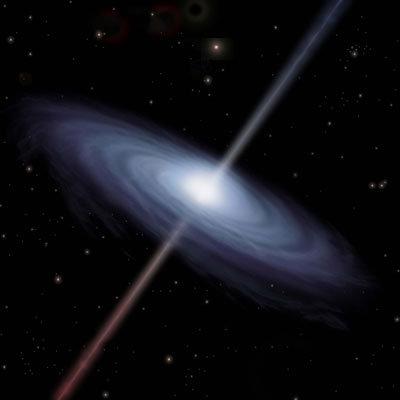This article is more than 1 year old
Big or small, black holes are all the same
When it comes to matter, anyway
Blackholes all gobble up matter in the same way, whatever their size, new research has found. UK astronomers say that the same processes are at work inside all black holes: the only difference is that of scale.
The researchers, led by Professor Ian McHardy, from the University of Southampton, began by looking for similarities between ordinary, stellar-sized Galactic black hole systems, and the supermassive black holes in Active Galactic Nuclei (AGN).
Their idea was that if certain similarities could be established, then the shorter-lived and faster acting "small" blackholes could give them clues about how the supermassive black holes would behave on cosmic timescales.

Professor McHardy comments, "By studying the way in which the X-ray emission from black hole systems varies, we found that the accretion or 'feeding' process - where the black hole is pulling in material from its surroundings - is the same in black holes of all sizes and that AGN are just scaled-up Galactic black holes.
"We also found that the way in which the X-ray emission varies is strongly correlated with the width of optical emission lines from black hole systems."
McHardy explained that the observations have important implications for the overall understanding of the different types of active galactic nuclei, which are classified by the width of their emission lines.
For example, Seyfert galaxies, which have very narrow emission lines, are often regarded as unusual. Now that the correlation between emission line width and X-ray emission has been identified, astronomers can see that Seyfert galaxies are not so different from other active galactic nuclei: "they just have a smaller ratio of mass to accretion rate".
McHardy and his colleagues have shown that the so-called characteristic timescale - that is the period over which the mass accretion rate will change appreciably - varies linearly with the mass of the black hole, but inversely with accretion rate. That is to say, the more massive a black hole, the more matter it can consume, but the longer it takes for the rate of accretion to increase noticeably.
This means that the mass of a black hole can be determined simply by measuring its accretion rate and characteristic timescale. Very useful when you are dealing with an obscured supermassive black hole at the centre of a dusty galaxy, for instance.
As a black hole accretes matter, it emits X-rays in a distinctive way, known as an X-ray light curve.
Professor McHardy concludes: "It has been known for over two decades that characteristic timescales can be seen in the X-ray lightcurves of Galactic black hole systems. The timescales are short (< second) and so can be found in short observations. However to find the equivalent timescales in AGN is much harder as we must observe for months or years."
The research is published in the current (December 7) edition of Nature. ®
